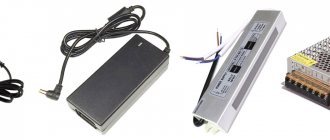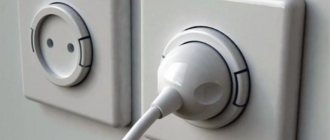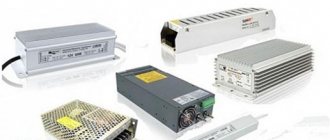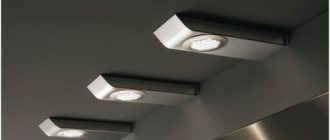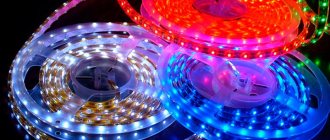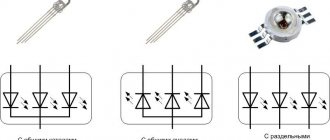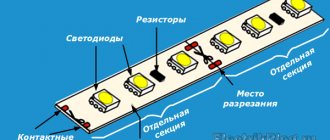LED strips are supplied to retail chains in reels of 5 meters (less often 2.5-10 m). There are wires at each end for connection. There are 2 technologies used in production - SMD and DIP. Self-installation requires calculation of the power of LED strips , electricity consumption, and parameters of voltage converters. Although the formulas are simple, a certain level of knowledge is required to obtain the correct result.
Types of LEDs
SMD diodes are mounted on a flexible tape using surface mount technology (soldered to the board). DIP packages are equipped with legs, so they are mounted on a flexible board before soldering. SMD strips are flat and emit light parallel to the mounting plane. DIP is a chain of cylinders that is used for tuning vehicles, for decorating large banquet halls, facades, outdoor advertising structures, squares, even trees.
To produce monochrome (single-color) LED strips, the same type of diodes are used. They can emit red, yellow, green, blue, white light, and less often orange or pink. Products with ultraviolet and infrared radiation are available for medical institutions, greenhouses, greenhouses. White light has different shades: yellowish, neutral, blue. When installing 3 crystals in one chip, it is called RGB .
The LED strip can be ordinary and waterproof (in a silicone shell) and is marked with the letters RTW.
The degree of protection is indicated by the letters IP and numbers:
- the first is safety for people and the level of protection from external mechanical influences;
- the second is the level of protection from high humidity;
- 0 – no protection.
When installed in heated rooms, protection is not of great importance. For wet rooms, a flexible LED strip with IP67 and IP68 is selected. For outdoor installation IP43 or more.
In a standard LED strip, the number of LEDs per 1 meter is 30 or 60. With a double increase in density, the product is designated as “x2”. If the LEDs are installed in 2 rows, they are marked “2x2” (120 or 240 chips per meter).
Attention! Some manufacturers offer flexible strips with LEDs installed in 3 and 4 rows. During installation, it is necessary to take into account that due to overheating, they must be placed on a rigid metal base.
LED strips with SMD are frontal, emit light at an angle of 120 degrees. Flexible strips with DIP are end-mounted; the light flux is scattered along the installation plane, so they are used indoors for decorative lighting.
Dependence of consumption of LED strips on their type
There are lighting products on sale that are divided into several types based on power. The most commonly used tapes are 3528 and 5050. When installing a lamp, you need to take into account the number of diodes and the amount of current consumed. This will allow you to select the correct power supply and use the system safely.
LED strips 3528
This product has a simple design and low power. Tape 3528 is produced on a flexible whole strip and on a slotted base, which is protected from moisture.
Visual data will help you better understand how much energy consumption occurs in 1 m of strip, depending on the number of light bulbs in it.
| Number of diodes in 1 m | Energy consumption |
| 240 | 19.2 W |
| 120 | 9.6 W |
| 60 | 4.8 W |
LF-3528 is also sold in 30 and 90 bulbs. For home use, tapes with 60 diodes are best suited, because... they do not heat up and are easy to install.
LED strips 5050
This product is developed using new technologies and has recently appeared on the market. The tape has a bright light with fewer bulbs. The LF-5050 is considered so powerful that it is installed on billboards and buildings. There are 4 subtypes of LED strips available for sale.
| Number of light bulbs in 1 m | Energy consumption |
| 120 | 25 W |
| 72 | 15 W (1.4 A) |
| 60 | 15 W (1.2 A) |
| 30 | 7.2 W |
Builders recommend using illuminators with 30 diodes in apartments.
Voltage and current
All types of LED strips are connected to the network through a power source that stabilizes voltage and current. Standard products are designed to operate from 12 volts , but there are flexible LED strips for 5 (with built-in PWM controller), 24 and 36 volts. Good manufacturers mark the value of this parameter on the tape.
The amount of current depends entirely on what LEDs are installed and how many there are on the meter and the entire strip.
Important! When purchasing a piece (without a reel), you need to ask the seller for the voltage and current values.
Checking the power supply
Checking is greatly facilitated if there is a source of appropriate voltage nearby.
To understand whether the LED strip is working or not, it is enough to apply the required 12-24-36V to it. You don't even need to solder the wires.
Connect two conductors to the output terminals of the block, and simply touch their tips to the outer copper pads at the beginning of the tape. If the glow is uniform and not dim, then everything is fine.
But when nothing lights up, you need to look for the reason. The most important assistant in this is a multimeter.
First of all, check whether the required voltage is coming out of the power supply? Maybe it's all about him.
You need to check between contacts “+V” and “-V”.
Or “+V” and “COM”.
If the voltage is normal (+ - 10%), then look further along the chain.
If you don’t have a multimeter, you can check using indirect signs. However, you should not rely on them:
- after applying 220V voltage, the green LED on the unit should light up
- if you listen, any power source in working condition should emit a faint characteristic noise
When this is not the case, then we can assume that the unit is faulty. After which, you still have to look for a device to measure the output voltage and confirm your guesses.
Power determination
On the packaging, the power of one meter or the entire product is indicated in watts. When choosing a power supply, the main attention should be paid to this indicator.
Attention! Recently they began to produce LED strips with a voltage of 220 V, for which a converter is not required, since they are connected directly to the network.
Calculation of the power of 1 meter of LED strip
The power value of 1 m of LED strip depends on the type of LEDs that are placed on it and their number. If there is no passport or the value is not indicated (not all manufacturers have a high level of responsibility), you need to measure the meter with a tape measure, determine the length and width of the chips and count how many of them are installed.
Based on the dimensions, you can determine the type of SMD and find a table with current values (in amperes ):
- SMD 3528 – 0.02;
- SMD 5050 – 0.02;
- SMD 5630 – 0.15-0.2;
- SMD 5730 – 0.15-0.3;
- SMD 2835 – 0.06;
- SMD 3014 – 0.03;
- SMD 3020 – 0.02.
Power formula:
P = U*I*N/K, where:
U – power supply voltage;
I – current;
N – number of chips per meter;
K – number of SMDs connected in series.
All 12V LED strips have 3 chips in groups connected in parallel, so K=3 (for 24V K=6).
Example:
The size of the SMD 3020 chip is 30x20 mm, 30 elements per meter, 12 V power supply.
P = 12*0.02*30/3 = 2.4 W.
If there are 60 chips:
P – 24*0.02*60/3 = 9.6 W.
Why do you need to find out?
An LED strip is a device that has a flexible base on which series-connected diodes are placed. This product operates using low voltage (12 or 24 volts).
Note! The most popular are 12 volt tapes. Their main advantage is that they are cheaper than 24 volt products.
Due to the fact that this product is low-voltage, there are difficulties connecting it to a standard 220 volt network. After all, if the connection is made directly, the 12-volt tape will simply burn out. Therefore, to connect LED products of this type, special voltage converters are used - power supplies.
Power supplies for LED strips
The power supply reduces the voltage of 220 volts to the required level - 12 or 24 volts. Today, there is a fairly large selection of converters to power these products, which makes choosing difficult. In order to choose the right power supply, you need to know what current or how many amperes the LED strip used for backlighting will consume. And this is not a constant value, which depends on the following parameters:
- length (how many meters are used). This product can be cut into various lengths. The main thing is that the cutting is carried out in clearly defined places. Otherwise, the tape will be damaged and will not work;
Note! This product is sold in reels. One coil contains five meters of LED.
Place for cutting
- led type;
- LED type;
- density of light sources.
All of the above parameters are necessary in order to calculate the power consumption of the LED strip, namely, what current or how many amperes it can consume.
Converter calculation
When purchasing a unit for an existing LED strip, not only power is taken into account, voltage is equally important.
Attention! 12 V converters are more accessible and have a relatively low cost; if they fail, they are easier to replace.
To determine the power of the block, the power of the tape must be multiplied by 0.2 or 0.3. For the LEDs discussed above, with length of 15 m and 60 chips on each of them, its power is:
9.6*15 = 144 W.
Taking into account the coefficient:
144+144*0.3 = 187.2 W
The power supply power should be 200 W.
Attention! If you do not take into account the reserve, the unit will not be able to produce a stable voltage at the output and will overheat.
If the block seems too large, the LED strip can be divided into 2 parts, for each buy a 100- watt .
How to correctly calculate the required parameter
To determine how many amperes or what current a 12 or 24 volt LED will consume, you just need to find out the type of product purchased and, using the table above, find out the required parameter. From the table we will get ready-made values for products with a length of up to five meters. Moreover, if the length of the backlight exceeds 5 meters, you simply need to add the required length to the final value of the table. Things are much more problematic when calculating the required parameters in a situation where the length of the backlight is, for example, 2.4 m. In this case, it is necessary to calculate how many LEDs there are per piece (in this case, 0.4 m). This can be found out by counting the number of diodes manually. After this, using the proportion method, you can easily calculate how much current a specific number of light sources will consume.
Diode placement
As you can see, each lighting installation will be exclusively individual in nature. Therefore, calculations must be carried out for each individual backlight. This will avoid the situation of premature failure of light sources due to violation of operating conditions. After this, you can safely select a power supply. Since the calculated amount of current consumed is the parameter by which it is necessary to select the converter. From the power supply you can power the LED with a voltage of 12, 18 and 24 volts. Having calculated how much power 1 m of the product has, you can easily calculate this parameter for the entire length of the backlight. To do this, the resulting value is simply multiplied by the total length of the lighting fixture. Note! When making calculations to select the optimal power supply, it is imperative to include 20-30% of the final result obtained, thereby forming a safety margin for the purchased converter. This amount of reserve must be made due to the fact that voltage surges sometimes occur in the network. They, in a situation where the power supply was selected without at least a minimum reserve of 20%, can damage it. This means that the converter may simply burn out. As a result, you will not be able to use your backlight until it is replaced. But there are situations when the diodes themselves fail due to overvoltage.
LED lighting in the room
To calculate the power consumption of the backlight, you need to simply multiply the power consumption of the entire backlight (taking into account 20-30% of the reserve) by the amount of time it will be turned on per day. For example, it is assumed that the LED product will work for four hours. But here in the calculations it is necessary to take into account the color of the LEDs.
Consumption calculation
Before installing a lighting system, anyone wants to know its energy consumption .
The amount consumed by an LED strip primarily depends on the number of diodes. If you use the product discussed above, then we can say that electricity consumption is the power of the power supply. To determine the exact value, you need to know how many hours daily the lighting system will be used.
If it works approximately 3 hours a day, the calculation is as follows:
200 W*3/1000 = 6 kW/day.
Main conclusions
The large volume of LED products offered on the market is not of high quality. Manufacturers do not indicate the parameters of voltage, current, power, or offer connection diagrams. The chips are made from low quality crystals and phosphors. When purchasing such products, to determine the current-voltage characteristics; calculations based on measurements are required.
If the tape is of high quality, it will serve the stated period only when connected through a power supply selected based on accurate calculations. Another condition is compliance with the operating regime.
When purchasing products from CREE, Philips, OSRAM, the system will work for the stated 30-50 thousand hours, if you take a responsible approach to the selection of additional components and installation. Calculations of power and energy consumption will not create problems, since these manufacturers indicate all the necessary parameters on their products.
